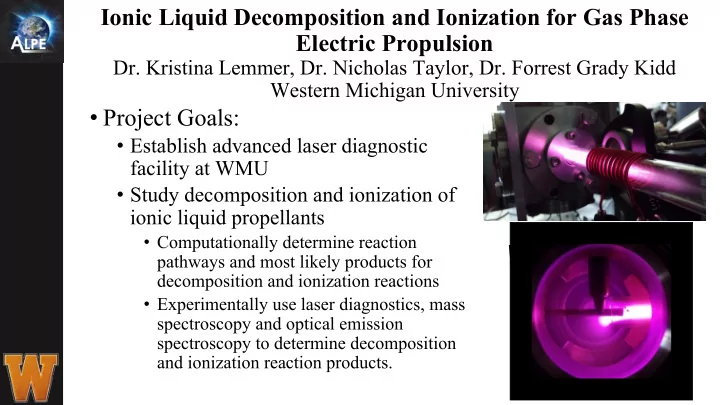

Ionic Liquid Decomposition and Ionization for Gas Phase Electric Propulsion Dr. Kristina Lemmer, Dr. Nicholas Taylor, Dr. Forrest Grady Kidd Western Michigan University • Project Goals: • Establish advanced laser diagnostic facility at WMU • Study decomposition and ionization of ionic liquid propellants • Computationally determine reaction pathways and most likely products for decomposition and ionization reactions • Experimentally use laser diagnostics, mass spectroscopy and optical emission spectroscopy to determine decomposition and ionization reaction products.
Breakthrough Discoveries Computational Effort Experimental Effort Plasma excitation of thermally decomposed HAN Deeper understanding of HAN/HEHN interactions • HAN introduced via passive thermal capillary system • Investigated connections between NH 2 OH+NO x and • Resulting species directly injected into an RF argon plasma NH 2 +HNO x Optical emission diagnostics of a HAN plasma • Improved kinetics for both species • Plasma emission collected via a fiber optic to a high resolution spectrometer • Most favorable pathways to N 2 O formation developed • Results complicated by thermal decomposition effects, transport effects, matrix & plasma (quenching) effects Improved safety - Better understanding of HAN/HA decomposition Plasma reactivity • H 2 O + is most common ion in HAN plasma • Most stable complexes and higher energy reactions defined • HEH is relatively stable, but after ionization, much more reactive, resulting in more decomposition
Transitions • Gas Phase Electric Propulsion – Field Reversed Configuration Thrusters (FRTs) • Interest from NASA • NEXT STEP program • AFRL/AFOSR interest • Currently funded AFOSR programs • “High Fidelity Modeling of Field-Reversed Configuration (FRC) Thrusters – AF future Interest in Electric Propulsion” • “Study of Vacuum Facility Effects on Pulsed Electric Propulsion System Testing” • Low pressure decomposition reactions • NASA GPIM program and other green monopropellant missions • Could help with catalyst identification
Recommend
More recommend